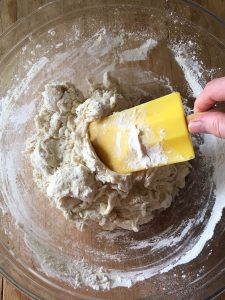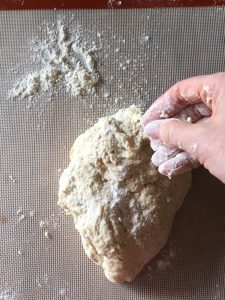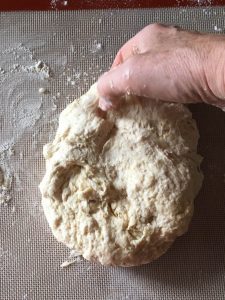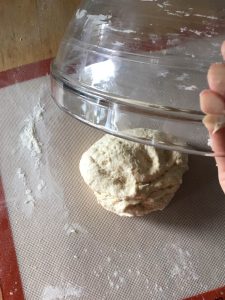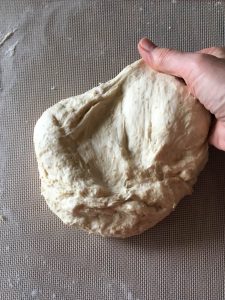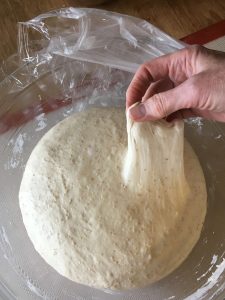There is no better place to start bread making than by kneading your dough by hand. It gives you a real feel for the transformation that takes place when wheat flour and water are combined. Even if you use a stand mixer or food processor to mix your bread dough or even if you try the no-knead method, you will learn a great deal about bread making from kneading by hand at least once.
Here is a step-by-step illustration of kneading by hand using our recipe for Butter Topped Toasting White Sandwich Bread.
- Place the water into a large bowl. Then add the yeast. Let it sit until the yeast dissolves, for about 5 minutes.
- Add the flour and dry ingredients to the water.
- Stir the flour into the water with a rubber spatula.
- Stir the mixture with a rubber spatula or dough scraper until the flour is moistened.
- Add the melted butter, if your recipe calls for it.
- To knead dough by hand, start by squeezing with your hands to bring it together into a loose ball.
- Continue squeezing and pressing the dough together to pick up all of the flour in the bowl.
- As the dough comes together, rub the ball of dough against the inside of the bowl to pick up every last bit of flour.
- Transfer the ball of dough to a lightly-floured work surface. Here I am working on a silicone baking mat that I’ve dusted lightly with flour.
- Dip your hand the flour. This light coating of flour on my hands helps keep the dough from sticking.
- Press down on the dough without squeezing. Pat it into a flat ball.
- To knead the dough, pick up one edge of the dough and fold it over.
- Fold the dough over onto itself. Repeat the last couple of steps several times.
- Once the dough feels somewhat firm under your hand, start to slap it onto your work surface. This is noisy fun and effective. First lift up the ball of dough.
- Then slap the dough back onto the work table.
- Fold the dough into a neat ball then lift it up and slap it down again. Do this for several minutes.
- When kneading bread dough by hand, time is your friend. Cover the ball of dough with the bowl you mixed the dough in or a with a kitchen towel. Let the dough sit for 5 minutes.
- Once the dough rests, the gluten relaxes making it easier to knead. See how much smoother it is?
- Keep folding, turning and pushing the dough until it feels springy under your hand. The dough will be smooth and alive.
- Once the dough feels smooth and springy, place it into a greased bowl. Cover the bowl tightly with plastic wrap and a kitchen towel.
- Let the dough ferment and rise in a draft-free place for the time suggested in your recipe. As it ferments, you may see moisture in the dough collect on the plastic.
- After 2 hours, the sandwich bread dough is alive. It has doubled in volume.
- The bread dough is silky smooth as you can see here.
- Press gently on the dough using the fingers on one hand. You’ll see the dough deflate. I press from the outside egdes and gather the dough up into a ball as I am doing this.
- The siky dough can be rolled into any number of shapes. Here I am rolling it into a tight oblong shape to fit my loaf pan.







